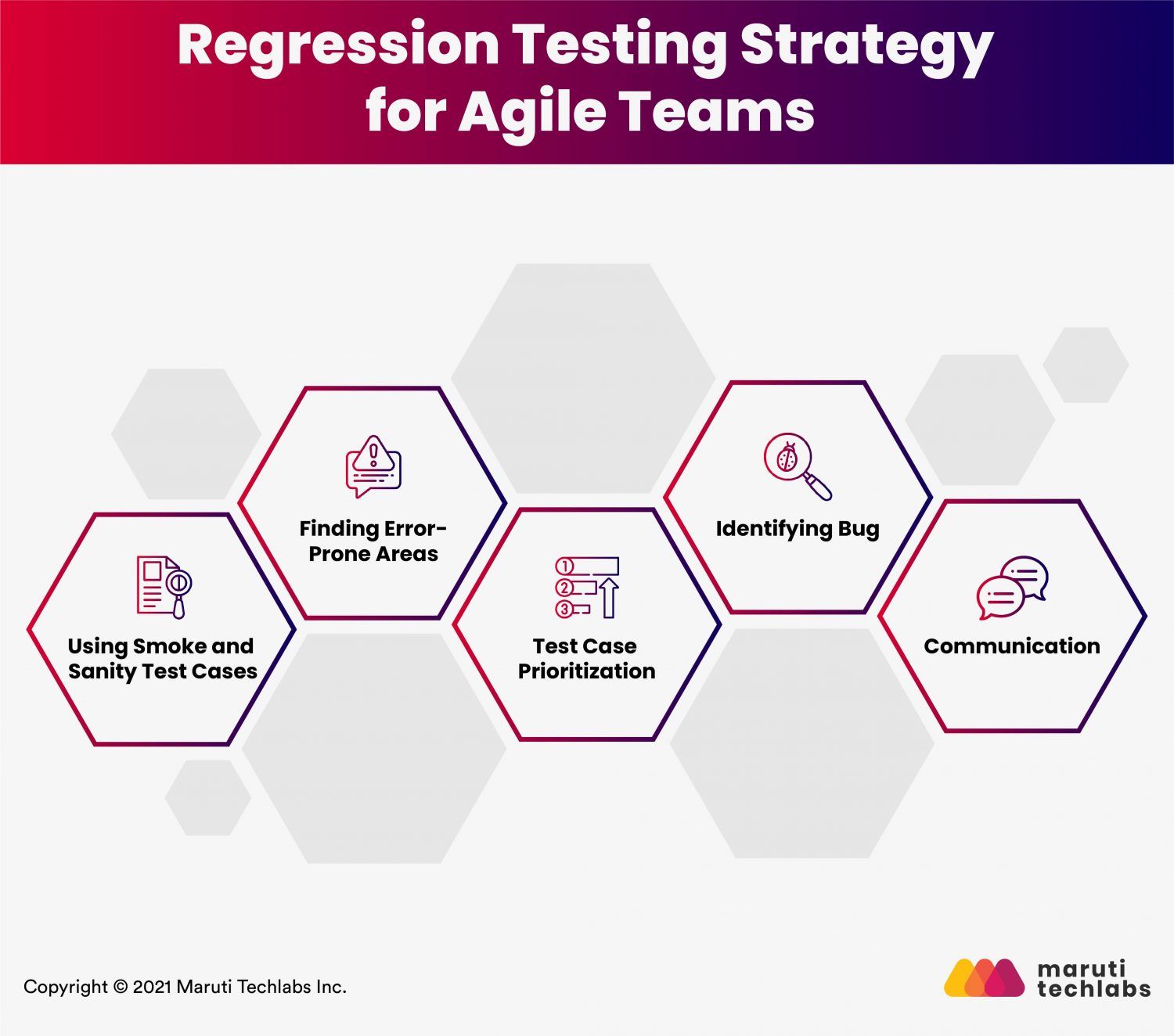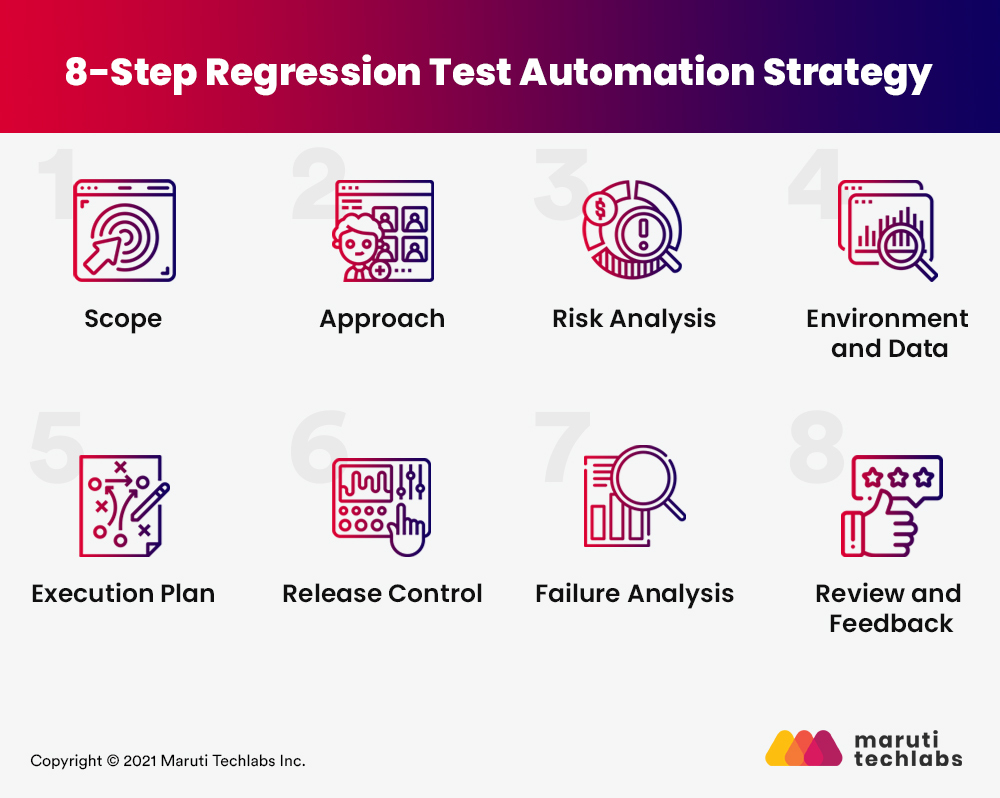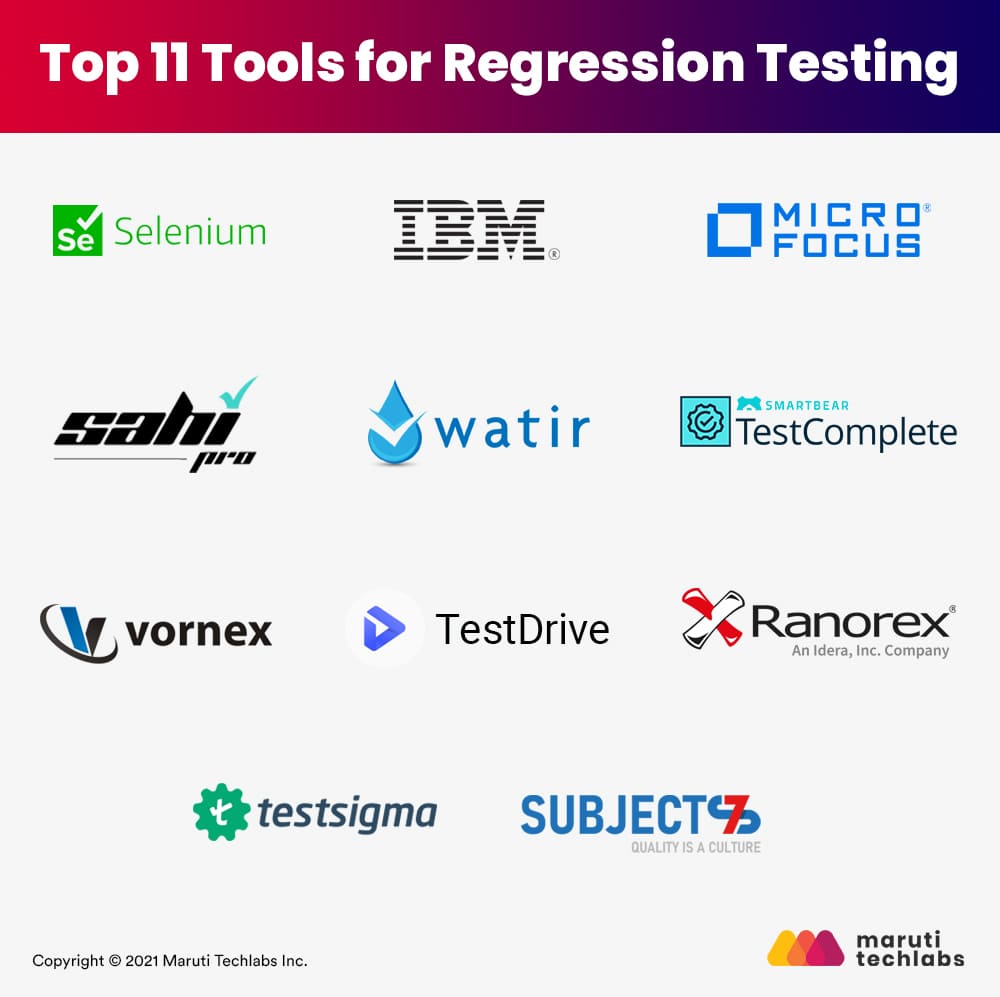Regression Testing Made Simple: Strategies, Tools, and Frameworks
Picture this: Your application is working smoothly. You customers are happy and you are excited to launch the new feature in the next sprint. The next sprint comes and with the deployment of the new lines of code, the existing functionality of your application breaks! Not only is the new code not working properly, but the existing coding features have stopped working. You and your team spend extra hours finding and fixing the issue, not to mention the loss of business and the bad reputation.
Terrifying? Yes. Uncommon? No.
Whenever the developer modifies their software, even a small change can create unexpected consequences. Hence it is necessary to check whether the modification of the software hasn’t broken the existing functionality within the software. That’s where regression testing comes into the picture.
Many top software development outsourcing companies provide regression testing services. These services involve thoroughly testing your apps and websites after any new features are added, or previous bugs are fixed.
Here, we have prepared a detailed guide to help you understand the need and importance of regression testing in software engineering and its strategies, tools, and techniques. Let’s get started by understanding what regression testing is.
What is Regression Testing?
Regression testing is a process of testing the software and analyzing whether the change of code, update, or improvements of the application has not affected the software’s existing functionality.
Regression testing in software engineering ensures the overall stability and functionality of existing features of the software. Regression testing ensures that the overall system stays sustainable under continuous improvements whenever new features are added to the code to update the software.
Regression testing helps target and reduce the risk of code dependencies, defects, and malfunction, so the previously developed and tested code stays operational after the modification.
Generally, the software undergoes many tests before the new changes integrate into the main development branch of the code. Still, the regression test is the final test among all as it helps you verify the product behavior as a whole.
When to Apply Regression Testing
The need for regression testing arises when the requirements of the software change, and you need to analyze whether the modifications in the application have affected the other areas of the software.
Below are some of the circumstances when you have to apply regression testing
- New functionality added to an existing feature
- For fixing the code to solve defects
- The source code is optimized to improve the performance of the software
- When the addition of fix patches is required
- Configuration of the software undergoes changes and modifications.
Importance of Regression Testing
Automated regression testing is considered a critical puzzle piece when it comes to the development of any software. The rapid regression testing process enables you and your product team to receive more informative feedback and respond instantly and effectively.
A regression test helps you detect errors in the deployment cycle so that you do not have to invest in cost and maintenance to resolve the built-up defects. As you know, sometimes a slight modification can cause a significant effect on the functionality and performance of the product’s key features. Therefore, developers and testers should not leave any alteration that can go out of their control space.
Change is the critical feature of regression testing. Below are four reasons for which changes usually take place:
- New functionality: It is one of the common reasons to undergo regression testing. Here, the old and new code should be fully compatible. Hence, when developers introduce new functionality, they don’t concentrate on its compatibility with the existing code. It is dependent on regression testing to find the possible issues.
- Integration: Regression testing ensures the software performs flawlessly after integration with another product
- Functionality Revision: As developers revise the existing functionality and add or remove any features, regression testing checks whether the features are added/terminated with no harm to the software functionality.
- Bug Fixing: Often, developers’ actions to fix the bugs in the code eventually generate more bugs. Therefore, bug fixing requires a change in the source code, which causes the need for re-testing and regression testing.
Functional tests only analyze the behavior of the new features and modifications and not how compatible they are with the existing functionality. Hence, it is difficult and mainly time-consuming to analyze the software’s root cause and architecture without regression testing.
Moreover, if your software goes through frequent modifications and updates, regression testing enables you to filter the quality as the product is modified.
Regression Testing Strategies
After understanding the importance of regression testing during software deployment, now it’s time to work with effective regression testing strategies. When you are designing regression testing strategies, it relies on two main factors:
a] Product Nature: It is a critical factor for deciding a relevant regression testing strategy and plan. For instance, approaches to test a landing page and comprehensive professional portal are different. Consider a landing page; regression testing mostly features UI and usability tests. On the other hand, the professional portal may consider multiple test cases for the software’s security, compatibility, and performance.
b] Product Scale: Regression testing works differently depending upon the large, medium, and small scale production. For instance, a single round of manual regression testing will be enough if the product is negligible. At the same time, for medium and large-scale developments, you will require both manual and automated regression testing.
If this doesn't match your expertise, contacting an IT consulting and CTO services company is best. These firms have experienced professionals who can provide guidance, technical expertise, and strategic direction to help you make informed decisions about your technology projects.
These factors enable the testing team to choose adequate regression testing strategies and approaches.
Regression Testing Approach
In total, two main approaches are available by which you can undertake regression testing. Remember, the approach you select will vary according to the circumstances, size of the codebase, your tester team, and if the product is negligible.
1. Full Regression
Here, the regression testing consists of all regression test scenarios covering the entire product. The tester team usually undergoes a full regression test at the final product delivery or release stage.
Full regression is generally performed when the product requires significant functional and non-functional modifications or when these modifications affect the root code of the software. Luckily, the tester team has just to revise the functional, non-functional, unit, and integration test suites and analyze these test cases that continuously fix bugs throughout the deployment.
Even though the task is tedious and lengthy, this approach effectively helps discover all defects throughout the application. However, when the system needs regular modifications and updates, full regression testing does not make sense.
For better understanding, consider a scenario where you have to build an image processing application. Here, the application was initially designed for iOS 8, so the developers used XCode6 IDE. Later, the customer asked to allow the user to run the product on the latest device powered by iOS 9. Therefore, the demand for a new IDE(XCode 7) transition arises. After the transition, testers had to perform full regression testing to ensure that all the features developed in XCode6 were still functioning effectively on xCode7.
Full regression testing can also be performed by customers when they want to get complete assurance about the product’s stability and its ability to satisfy their needs.
2. Partial Regression
Partial regression testing is the process of testing modified parts of the software and the adjacent areas that might have been affected. Testers make use of unique strategies to make sure that the partial regression testing yields good results.
The primary strategy here is a risk-based approach. Testers determine the application areas affected by recent modifications and select relevant test cases from the test suite.
A quality assurance team further applies the risk-based approach to perform regression testing when the software acquires new changes. This selection technique reduces the testing time and effort and is one of the better choices for iterative regression testing for agile deployment when teams are pressed for time.
Note that partial regression testing also considers full regression testing for the final deployment stage and discards obsolete test cases.
Remember that the choice of an approach will depend on the scope of changes, stage of the software life cycle, and methodology.
How to Build a Regression Testing Strategy for Agile Teams
Before you start building the regression testing strategy, consider the following:
- Collect all test cases when you intend to perform
- Analyze the improvements that can be made to these test cases
- Calculate the time required for performing the test cases
- Summarize that can be automated and how
After considering all these points thoroughly, let us start building the regression testing strategy:

1.Using Smoke and Sanity Test Cases
Smoke and sanity testing is carried out before the regression testing, which eventually helps to save time for the testing teams. Sanity testing is run through the basic features of the software before additional testing of the new release, which controls that functionality works as planned.
To carry out smoke testing, you require a subset of test cases that test basic and core software workflow, for instance, startup and login, and can run very quickly.
You can use a smoke and sanity test to quickly identify whether an application is too flawed to warrant any testing further such as regression testing. This procedure is much better than performing regression testing on software that doesn’t load login and starts analyzing why hundreds of thousands of regression tests fail.
2.Finding Error-Prone Areas
Consider a test case scenario that often fails. Some features in the application are so error-prone that they always fail after minor code modifications. During the software lifecycle, you can analyze these failing test cases and include them in the regression test suite.
3.Test Case Prioritization
Regression testing focuses on the software areas with the most significant risk of quality issue. While working with a risk-based approach, a tester must select the test case that covers most of the application areas affected by the changes. You can also rank them according to priority.
The best way to deal with it is to prioritize the test cases according to critical and frequently used software functionalities. When you choose the test cases depending on their priority, you can reduce the regression test suite and save time by running fast and frequent regression tests.
4.Identifying Bug
Some regression testing tools integrate with error analyzing tools. It lets you see the details about what happened while performing the regression test; if it fails, research which features fail and exactly which line of code is affected. Error tracking tools help you get screenshots and other metrics about the failure during the regression testing, helping identify and debug the issue.
5.Communication
The tester should communicate with the software owner to analyze changes in requirements and assess them. They should communicate with the developers to understand the changes made during an iteration.
As a web application development company, we understand the importance of effective regression testing strategies. Whether you're an Agile team or looking for a custom web application development solution, our comprehensive guide will help ensure your software stays bug-free and reliable.
Challenges Faced by Regression Testing
Below, we have discussed some common challenges faced while performing regression testing and make it difficult for the agile team:
- Changes: Many-a-times, excessive changes are necessary by the management and customer. This modification can be volatile if the whole iteration terminates. These create a high risk to any test automation strategy.
- Unable to use record and playback testing tools: The development and tester team must wait until the functionality is ready to employ traditional test tools with record and playback features. Hence, automated functional testing tools don’t work in an agile context.
- Regression test growth: It is obvious that while working with the large project, regression tests quickly become unmanageable. Therefore, the tester team should automate and review tests frequently and remove ineffective tests to ensure that regression testing remains managed.
- Lack of communication: It is essential to communicate effectively between the automation testing team, business analysts, developers, and customers. It helps to know the changes in the product-which functionality is research which features fail new. They require regression tests, which functionality is undergoing the difference and is removed and no longer needs regression testing.
- Test Case Maintenance: As you know, the more test cases you automate, the clearer the quality of the existing functionality is made. But at the same time, more automated test cases mean more maintenance.
- Special testing skills: You will need specialists to test the functionalities such as integration and performance testing. The team should hire specialists either within the agile team to gather and plan testing requirements.
Regression Testing Methods
Generally, there are two primary regression testing methods implemented on software. Let us understand them in detail below:
1.Manual Regression
Manual regression testing is one of the most basic methods for regression testing for every software regardless of the methodology used in the software, i.e., waterfall model, agile, and others. A regression test suite depends on the test cases describing areas of the application that have undergone modification.
Manual testing always precedes automation, sometimes even more efficient than the latter. For instance, it is impossible to write the test scripts for testing the software areas adjacent to the modified code.
Manual regression testing is more efficient in the early stages of the product delivery process. For example, while developing the iOS image processing software, manual regression testing enables you to detect several bugs causing defects in the app UX. Therefore, the app fails to render the image correctly and crashes when the user changes screen orientation.
However, the main problem with manual regression testing is that it is effort and time-consuming. For complex software, running a regression test, again and again, hinders a tester’s concentration and performance. Hence in these cases, tester teams prefer working with automated regression testing.
2.Automated Regression
Automated regression testing is mainly used with medium and large complex projects when the project is stable. Using a thorough plan, automated regression testing helps to reduce the time and efforts that a tester spends on tedious and repeatable tasks and can contribute their time that requires manual attention like exploratory tests and UX testing.
In the current situation, the tester often starts automated regression testing at the early stages of the software development life cycle. It works well enough for agile development where the developers look forward to deploying the product at least weekly and have no time for warming-up manual regression testing.
The tester team can understand the stakeholder’s needs and the product business logic by communicating with the whole team and studying the use cases thoroughly to find the expected results for testing. The primary task in early automation is to decide the testing framework which provides you with easy scripting and low-cost test maintenance.
In some instances, automation testing allows you to detect the bugs found during manual regression testing. For example, while building an image processing app described above, automation lets you see random bugs using automated testing timeouts.
Balance Between Automated and Manual Regression Testing
While working with automated regression testing, you must wonder how many tests should be kept manual and how many automated. Hence, before understanding the balance between automatic and manual testing, let us know what automation can and cannot do.
How to do Automated Regression Testing
Automation robots are created to do exactly what you command them to do, nothing more or nothing less than that. Automated regression testing enables you to find your known unknowns rather than seeing your unknown unknowns. Confusing right? Let us understand in detail.
Testers will always continue to fulfill the task of monitoring, evaluating, and updating the test case that they created as the software undergoes the modifications. But also, their task is to think outside the box and look at the potential issues in the system.
The best part of automation is that it creates a positive cycle, i.e., the more tedious, repetitive tasks you automate, the more capacity you free up for yourself, which enables you to find these issues in the system’s existing functionality through exploratory testing.
Note that it does not matter whether the test case is 100% manual or 100% automated. Any test case can be partly automated if it includes repetitive tasks such as logging in to an application or filling in user information. Therefore, the ideal approach to regression testing consists of continuous focus on efficiency and time optimization through automation and critical evaluation of new and existing test cases.
By considering a balanced regression testing approach with automation opportunities as a core focus, you can ensure that the project stays on track and budget. Also, it helps you ensure that your software stays bug-free and eventually helps you to give your end-user the best possible user experience.
Regression Test Automation Strategy
Getting started with the regression test automation strategy is pretty simple. Just follow the below eight steps, and you are good to go.

1. Scope
The scope is the first step to consider when you get started with automation in your regression testing.
It helps you to define which test case should be automated and which should be manual. Moreover, it also consists of outlining timelines and milestones for each sprint in the project.
It is crucial that all team members are on board with this scope, and each one knows their responsibilities for certain parts of the project.
2. Approach
When you consider the regression test automation approach, below are three major areas you should consider.
a] Process
It is essential to have a well-defined structured process while building your automated regression testing suite. Make sure that you cover the following in your plan:
- When should we create an automatic test case during the sprint?
- When are features ready for automated testing?
- Which parts are manually tested?
- Who takes care of maintenance?
- How do we analyze results?
b] Technology
Before starting automation testing, you must identify which application you need to automate and what technologies they use. Eventually, it will help you to determine which automation tool you should use.
In many cases, regression testing will involve several application types: desktop-based, web-based, mobile apps, etc. hence, it is essential to have a tool that handles all your automation requirements.
Generally, the tester starts automating with a free, open-source tool such as selenium. Still, later, it causes problems as selenium helps to cover only some of their regression testing needs. Also, testers and developers often spend a massive amount of time writing automation scripts and maintaining all those scripts down the line.
c] Roles
At this point, you have to define the roles for automation in your team. As regression testing is not the only thing you must automate, you need to keep an overview of who does what in your team.
For instance, the roles and responsibilities consist of:
- Automation Lead: Responsible for handling and controlling all activities regarding the automation in the project
- Test Case Reviewer: It is essential to create automated test cases like code reviews among the software developers.
Eventually, more and more time will go towards the maintenance of the regression suite. Hence, using a regression testing tool is essential to keep a clear overview of your testing suite. Also, it allows you to administer roles and access to automation flows and suites.
3. Risk Analysis
Risk analysis should be a significant part of automation strategy as a whole. It is pretty tricky and time-consuming to foresee everything that can fail, estimate the cost of this, or find a way to avoid those risks.
Depending on the business size, complexity, and importance of your business processes, you can carry out this risk analysis by simply answering the below questions to yourself.
- Describe the risk factor
- What will happen if the risk becomes a reality?
- What is the probability that it will happen?
- What steps should be taken to minimize the risk?
- What is the cost of reducing the risk?
If you are not likely to do this, you can also consider a more extensive risk scenario, cost calculations, and mitigation strategies.
4. Environment and Data
The next step in automation regression testing is testing the environments and the data.
Companies with the software department will have more or less well-defined methods for software deployment. This process usually involves one or more test environments.
Some release pipelines are well-defined(i.e., DevOps pipeline), and the work towards the fast release has either begun or been deemed. In this case, it becomes essential to evaluate the current state of your test environments.
Test automation will produce predictable outputs for known inputs. It means that stable and predictable test environments are essential for successful test automation.
5. Execution Plan
After considering the scope of your project in terms of timeline and responsibilities, now it’s time to turn it into an executable plan. An execution plan should consist of day-to-day tasks and procedures related to automated regression testing.
Before adding any automated test cases to the regression suite, it’s essential to run and verify the tests multiple times to ensure they run as expected. Failure is time-consuming, and so the test cases must be robust and reliable.
It is an excellent plan to create a procedure for making test cases resistant to automated changes in the system. This procedure will solely depend on the application, but it should consist of the test cases that recognize and interact with the application’s elements under test.
It means that the regression tests will run either as a deployment event or at a known time.
6. Release Control
In any release pipeline, there comes the point when the team needs to decide whether to release a build regardless of its complexity and maturity. Areas of this decision-making can be automated, while other features still require human critical thinking.
Remember that the automation results will play a critical role in this decision. But if you only want to allow release or if you want to have a lead tester, it depends on you.
After the complete process of regression tests, you should include application logs as part of the release decision. If the regression tests consist of application coverage, errors not related to the UI should be revealed in the log files.

7. Failure Analysis
It is essential to plan to analyze the failed test cases and take action after the critical situation. The time consumed by the tester declaring a fail test case until it is fixed and accepted back in the development is usually more significant than teams anticipate.
As a result, the release cycles risk being delayed, and the agile team becomes less agile. But instead, having a well-defined process will help you save a lot of time and frustration throughout the release cycle.
The best practice is to outline how different bugs should be handled and by whom. For instance,
- Environment Errors: Handle by DevOps Team
- Error in the application under test: Report a bug for development
- Error in the automation scripts: A task for the test team
8. Review and Feedback
After processing your regression testing automation strategy, it’s time for you to get it reviewed by all development team members. Ensure to enforce a continuous improvement and learning process, which consists of feedback from peers, stakeholders, and team members working with automation and adjusting the strategy when needed.
Even though automated regression testing is the priority for the tester team to automate, that doesn’t mean that regression testing should not be manual.
Tester’s automation choice needs to be done continuously, and the test cases can be reused. But you cannot ignore the fact that manual testing delivers higher quality at a lower cost.
Regardless of automation prowess, below are some of the steps you should be following for manual regression testing:
a]Analyzing the Problem
Are there any problem areas in your software? Is there any functionality that is prone to break or receives a massive amount of customer service issues? Maybe this functionality or areas are:
- Used most frequently
- Easily affect the updates and modifications
- Often misused by users
- Prone to hacking attempts
In addition, you’ll also need to decide about the different testing components to include in this round.
b]Dividing and Conquering the Testing Surface Area
At this point, you are available with a long list of what to test, and you have to divide it into individual test cases and exploratory test prompts in your test management software such as TestRail or JIRA.
While test cases will enable the testers with exact steps and exploratory test prompts will assign certain functionality or areas to the expert tester to intuitively create their test cases.
c]Error Report with Steps and Screenshots
Whether your team consists of 5 testers or 50, you inevitably need complete consistency with the bug reports. The ideal error report includes:
- The functionality name.
- The environment.
- Steps to reproduce.
- The expected output.
- The actual output.
- The assumed priority of the issue.
d]Confirm Testing Coverage with Testing Resources
You have to confirm from your team what is covered until now after completing all the testing. Make sure that everyone marks tasks as done in your manual test management. Also, review the bug report if any feature areas of the software are found missing.
e]Save and Reuse your Test Cases
Now it’s time to review the test case and exploratory test prompts and check whether they fit into your regression testing strategy overall.
- Which test cases can be reused?
- Which test case should be rewritten to reuse?
- Which test case should be deleted from your ongoing regression testing strategy?
Remember that regression testing can be overwhelming because of the inherent complexity, but you can keep yourself and your team on the right track when you use his processes.
What are the Factors to Choose the Right Tools?
There are few factors that you should consider to make a tool a good choice for regression testing. Some of these factors are mentioned below:
- You can create test cases easily.
- A test case is maintained easily.
- Complex test cases can be automated.
- Finding a gap that exists during the requirement cycle.
- Depending on the type of application you possess, the tool support for test case execution.
- It is easy to understand and maintain the structuring for test cases and test suites.
- Either the tool has to support integration with good reporting tools or should have its mechanism.
- The tool supports the test cases execution on supported devices.
- The tool should be integrated well for QA in CI/CD pipeline seamlessly.
Top 11 Tools for Regression Testing
There are many popular tools available that help the tester execute the tests quickly and save huge time. It would be challenging to develop the best tools, but let us discuss some of the top tools used by QA specialists for regression testing.

1.Selenium
- It is one of the most powerful regression tools that perfectly fit the frequent regression testing.
- Highly Flexible and supports numerous programming languages
- It is compatible with many browsers and OS
- Many massive browser vendors consider selenium the native part of the browser.
2.IBM Rational Functional Tester
- It is a commercial tool that is often referred to as the best-automated regression testing tool.
- It supports various apps, including web-based and terminal emulation-based.
- Using IBM rational functional tool, users can easily create different types of scenarios.
3.Testsigma
- Testsigma is an automated regression testing tool.
- Testsigma helps you with scriptless testing in plain English.
- It offers suggestions of related test cases after a change has been made.
- It lets you run your regression tests right after the first check-ins, automatically, within a sprint.
4.Sahi Pro
- It is used to test large web applications, especially in challenging deadline projects when minimum maintenance is required.
- It offers OS support and easy integration with the build system, default logging, and data-driven suits.
- The most crucial feature of SAHI PRO is that it is flexible.
5.Watir
- It is an open-source tool for web application regression testing.
- Watir mainly uses the Ruby programming language and supports various apps developed in different technologies.
- It is lightweight and very easy to use
- Watir offers cross-platform OS support, possess a default-test recorder, and also allows writing tests that are easy to maintain
- Watir is used by many large companies like Facebook and Oracle.
6.TestComplete
- TestComplete is suitable for running parallel regression tests.
- It helps to create automated regression tests across the web, desktop, and mobile applications.
- These tests are unbreakable and stable under the GUI modifications
- Among the highlights, we should mention test visualizer, custom extension, and test recording
7.Silk Test
- It is a popular regression testing tool that supports desktops, mobile, rick-client, web, etc.
- It is possible to run tests parallely, which reduces the testing time and provides quick feedback.
- SilkTest is mainly used to make the most complex test plan look clear and neat.
8.TimeShiftX
- TimeShiftX operates on virtual time, and hence system clock changes are required. It helps shift the dates and force the time to perform temporary or date simulating testing.
- You can make use of this tool for testing databases and applications on all platforms and OS.
- TimeShiftX is easily customizable and requires no code modifications or environment reboots.
9.TestDrive
- TestDrive is a solution for fast regression testing, which is dynamic and flexible.
- Unlike the majority of automated regression tools, it supports manual testing.
- TestDrive supports multiple technologies, application types, and interfaces at the same time.
- It is beneficial for testing browser apps and GUIs among various visual regression testing tools.
10.Ranorex Studio
- Ranorex is the ultimate solution for test automation which is highly suitable for working with desktops, web, and mobile apps.
- It is perfect for every company irrespective of its size.
- It includes a codeless integration with multiple tools like Jira and TestRail, data-driven and keyword-driven testing.
11.Subject7
- Subject7 is a cloud-based no-code platform that supports automated regression testing of any mobile or web application.
- It supports high-scale parallel execution and is available for use in the secure public cloud and a private cloud along with hybrid deployments.
- Subject7 enables you extendable capabilities for adjacent test automation.
Apart from these, there are many regression testing tools available in the market. You have to be careful while choosing the correct tool based on your requirements.
Conclusion
For regression testing to be efficient and effective, it is necessary to see it as an open part of the comprehensive testing methodology. Incorporating enough variety of automated tests to prevent any aspects of your application from going unchecked is a cost-effective way of carrying out regression testing.
At Maruti Techlabs, our QA experts run automated test cases, develop change reports, and perform risk analysis with extensive code coverage. Our QA and software testing services focus on modern as well as legacy systems to give you unmatched performance with streamlined execution. For rigorous quality checks to ensure flawless performance at every stage, reach out to us here.



















